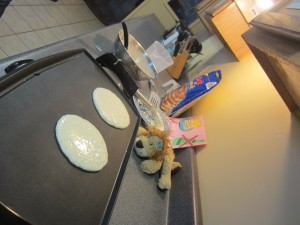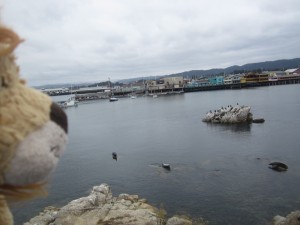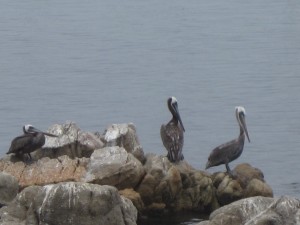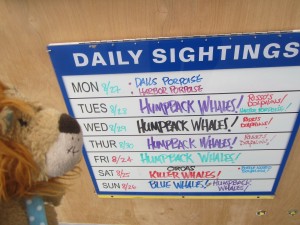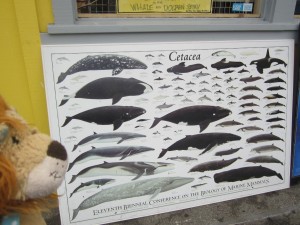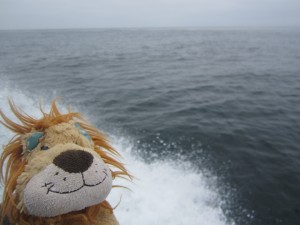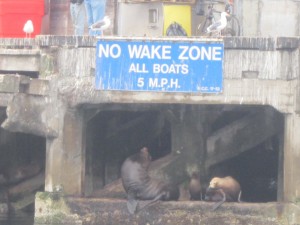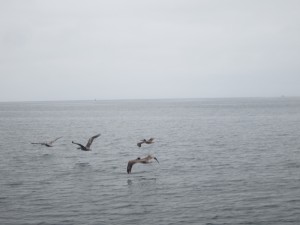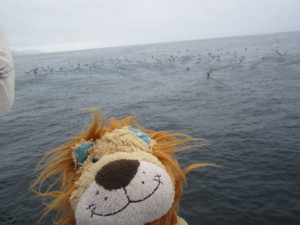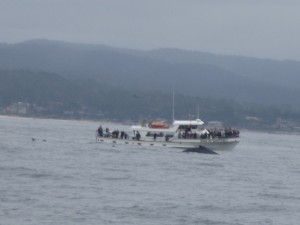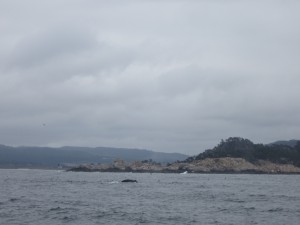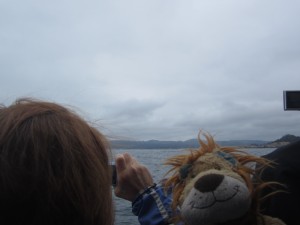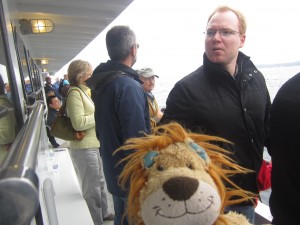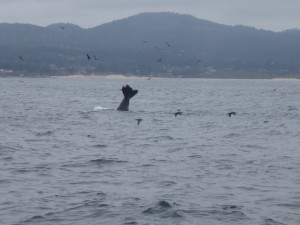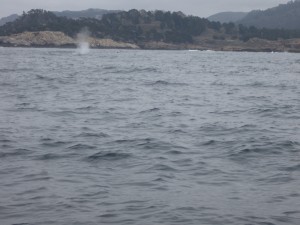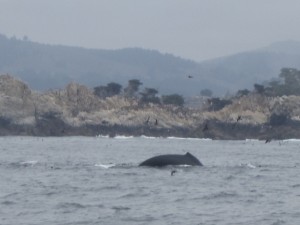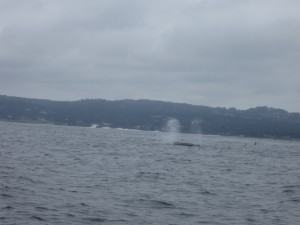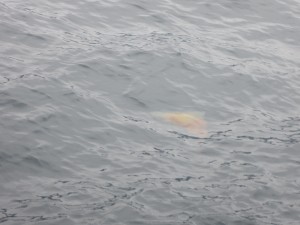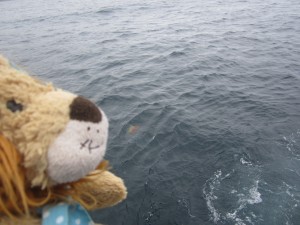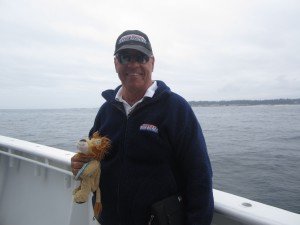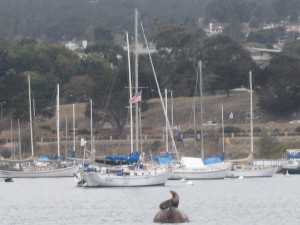So, Lewis the Lion was just in luck! He’d arrived at his hostel in Monterey and he’d managed to secure a place on the next morning’s whale watching trip! He was delighted as he’d wanted to experience the same when he was in Ecuador but he’d ran out of time after visiting the line of the Equator in Quito. ‘All good things come to those who wait,’ his wise mother had always told him. Or another of her favourite lines was, ‘If it’s meant for you, it won’t pass you by.’ Lewis the Lion felt that these wise saws and sayings were very appropriate for him at this moment in time.
So after an American pancake breakfast,
he and Helen had a mile or so to hurry along to the Fisherman’s Wharf where the boat was waiting. On their way there they learnt that Monterey was in a tsunami hazard zone and that should there be an earthquake, that they should head inland or for high ground.
He also learnt that Monterey had once been home to one of America’s famous sons, John Steinbeck, the acclaimed writer. Lewis the Lion wondered if this quaint fishing town was inspiration for his any of his writing? His suspicions were confirmed when he read a little further on that Steinbeck had written a book about Monterey’s famous fishing industry in 1945 called Cannery Row.
“It is a fabulous place; when the tide is in, a wave churned basin, creamy with foam… But when the tide goes out the little water world becomes quiet and lovely.”
John Steinbeck
Lewis the Lion discovered that Monterey was indeed famous for its fish and in particular its tinned sardines. Lewis wondered also whether that was the reason multiple different animals and seabirds chose to make their home here too? He could see lazy harbour seals sprawled out on the rocks,
as well as groups of pelicans and cormorants.
He only hoped the whales he was hoping to see that day would have a similar reason for being there…
When he arrived at the ticketing office with Helen, he was excited to see a notice board showing the company’s success rate at managing to find whales in the past few days. There had been sightings of humpback whales, orcas (also known as killer whales) and blue whales as well as other marine life. How exciting!
Lewis the Lion hoped that he would be so lucky. He noticed that onboard the boat today, the Princess Monterey, were marine biologists would would help explain all of the wildlife that they might encounter.
He also took his time to study a poster which showed all of the different whale groups: he was surprised by how many there were.
He also discovered that the scientific name for the whale family is ‘Cetacea.’ What Lewis the Lion found fascinating about whales is that even though they live in the sea, they are not a fish but in fact a mammal. ‘How cool is that?’ he thought himself but couldn’t imagine living in the water all the time himself! With any luck, that would mean that if there were whales in the area, he would be able to see their blow-holes as they came up to the surface to breathe. He was going to watch out very carefully!
So as the boat pulled away from the harbour, he kept his eyes fixed on the horizon for two reasons. Firstly because he wanted to be the first little lion to spot a whale, of course but secondly because the journey out to sea was rather choppy and he didn’t want to feel seasick like that time when he was in Amantani on Lake Titicaca. The spray from the waves as the boat bounced over them certainly helped to cool things down and Helen at least was grateful for her extra layers of clothing.
They hadn’t gone very far when the captain on board deck pointed out a colony of noisy (and smelly!) seals.
Lewis the Lion also saw brown Californian coastal pelicans flying by. He thought they looked like a throw back from the times of the dinosaurs with their long beaks, reminding him of pterodactyls.
After an hour or so of sailing out along the bay of Monterey, the boat reached the bay of Carmel and the captain told the passengers that there was a good sign that whales were in the area as there were lots of birds feeding on top of the water, indicating plentiful supplies of fish. The fish were also likely to draw the whales in too.
The captain who was high above from the look out point then told the passengers that if he saw any whales he would let them know by using the hands of a clock, imagining that the front of the boat was twelve o’clock. Therefore, if he said ‘nine o’clock’ he’d be talking about the lefthand side of the boat and if he said ‘three o’clock’ the action would be taking place on the righthand side of the boat. His first sighting was at ‘eight o’clock’ and the passengers swarmed to the lefthand side of the boat to see if they could spot their first whale?
“Wow!” was the audible gasp of the passengers aboard ship and Lewis the Lion and Helen were no exception. The enormous, beast of a whale had surfaced right near another boat which was out whale watching as well. It was a humpback whale! And it wasn’t on it’s own.
There were in fact about four or five of them out feeding this particular morning. Lewis the Lion was in awe at these great mammals. Helen tried to take photos but with the constant rocking of the boat and holding onto Lewis, it was difficult to free a hand to take photos without wobbling into people.
The captain told people that they should always try to hold onto a rail whilst on deck.
So, she did her best to try to capture the moment, including this video where Lewis the Lion learnt about a poor humpback whale who had part of its tail bitten off by an orca when it was just a calf. The marine biologists had a special nickname for this whale – “Shrek!” and told the passengers on board that there was no mistaking this one with half a tail.
Take a look at this video on YouTube and then this one to see how Lewis the Lion was delighted to see the whales in their natural environment.
Lewis the Lion was then enchanted as he saw lots of blow-holes shoot up time after time before the great mammals would then rise up out of the ocean.
He couldn’t imagine how much energy they must expel to propel themselves out of the water in this way. ‘What amazing creatures they are!’ he thought to himself.
He could have stood and watched them all day long as he was truly wowed and mesmerised by these humpback whales.
However, it was time for the boat to return to base and Lewis the Lion felt truly grateful for having had this incredible encounter with whales in their natural environment. As the boat turned around, Lewis the Lion spotted enormous yellow and orangey coloured jellyfish in the water,
as well as a big group of seals, splish-splashing around in the water together. It looked like they were a group of children who had been let out at playtime!
Whilst they ventured back to Monterey, Lewis the Lion had an interesting discussion with the captain who was also a marine biologist.
He asked Lewis the Lion whether he knew that we know more about space than we do about the ocean depths? Lewis the Lion couldn’t understand why but then the captain explained that it’s about the great pressure underwater which crushes things as they go deeper and deeper. It’s for this reason that we still don’t really know how whales give birth in the wild as no diver would be able to get to the depths required. As always, Lewis the Lion loved the fact that this world is still filled with so many mysteries waiting to be discovered!
Lewis the Lion once again felt humbled and in awe at this beautiful world in which we live in. Whale watching in Monterey Bay had been a unique and fabulous experience and he felt for certain that he was the luckiest little lion on this planet.
What mysteries of the planet would you like answered? How might you begin to find out the answers to your questions?

